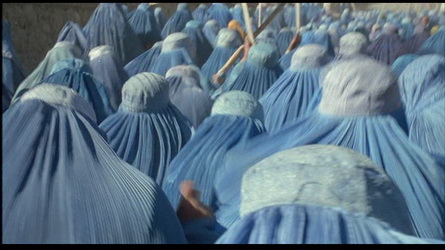
Arch
443/646: Architecture and Film
Fall 2011
Osama, Persepolis and Waltz with Bashir
 |
Arch
443/646: Architecture and Film Osama, Persepolis and Waltz with Bashir |
|
Discussion Questions:
Remember, your images are ABOVE your name.
Please answer the questions below. Use paragraph form. Email me your responses in Word .doc or .docx format to: tboake@sympatico.ca I will be posting these each week after the class. You should be prepared to deliver your answer in class -- but paraphrase, do not read it. THINGS TO KEEP IN MIND WHEN ANSWERING THESE QUESTIONS: The three films in this question set are all set in Middle Eastern countries that continue to experience high levels of politically driven conflict - Afghanistan (Osama), Iran (Persepolis) and Lebanan (Bashir). The directors of these films all use very different cinematic approaches to telling their stories. All of the stories are based on real or realistic events. Most of the questions will attempt to provoke thinking and discussion about the relative success or appropriateness of the varied approaches to conveying and convincing us about the subject matter. |
x |
|||||
| 1. | 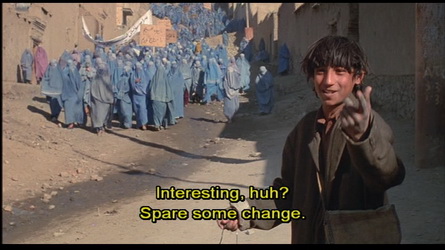 |
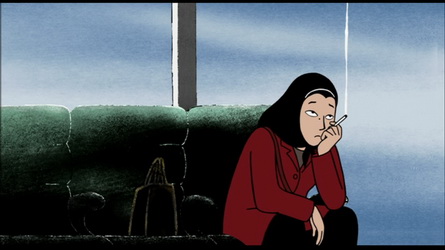 |
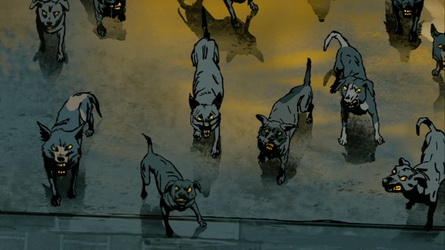 |
||
Jennifer Beggs For me, because Osama was not animated, the real-life footage was able to better draw me into the beginning of the movie to make me feel as though I were a part of the opening scene itself. The shots of the boy performing the chants and asking for money was shot at an angle similar to eye-level, so as to make the viewers feel they were the ones standing in front of the boy, on the road in Afghanistan. The angle of the shot put me, as part of the audience, directly in the character of the atmosphere. When the crowd of women are running, being chased by the men in carriages, the camera shot is shaking and is at an angle that imitates what a person would really be seeing. The way of filming this makes me feel like I am there, experiencing the drama. It makes the scene very believable and thereby is very effective in drawing me into the subject matter of the film right from the very first shot by making me feel a part of the movie. In the beginning of Persepolis, we see a “flash forward” of Marjane at the airport, as an adult. She appears very depressed as she sits down in the airport lounge with a very “unimpressed” look on her face smoking a cigarette. For me, this was very successful in capturing my curiosity, causing me to wonder why she appears the way she does; it makes you wonder what brought her to this point. She portrays strange behaviour as she avoids talking to any other characters (including the woman at the airport check in counter). This encourages the viewers to speculate as to what might have happened to get the woman to this stage. It promotes questions such: ‘Why is she alone?’ ‘Where is she going?’ ‘Why is she upset?” “Did something just happen?” “How long has she been this miserable?” Without even revealing the plot or narrative, this draws people into the film through curiosity. Waltz with Bashir opens with a pack of dogs running down a road late at night, all growling and visually worked up. This portion of the movie lasts approximately 2 minutes. The music in this scene is somewhat eerie, but is very soft and lacking dramatic effect. In my opinion it doesn’t capture interest and curiosity of an audience as successfully in the opening minutes the way that Osama and Persepolis do. For me it did not provoke as many questions concerning the subject matter of the film. It is not abnormal to see dogs running and barking and I believe because this is natural behaviour for animals, it did not spark special curiosity to grasp my attention and draw me into the subject matter of the film the way the other two movies did.
|
|||||
| 2. |
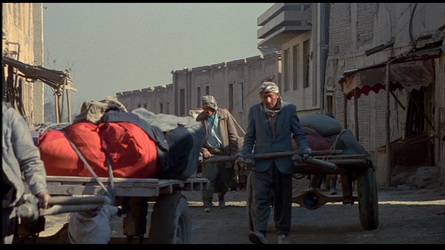 |
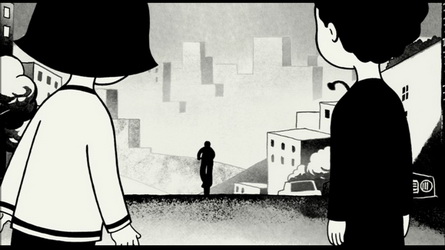 |
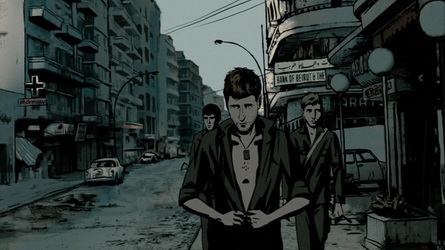 |
||
Jaliya Fonseka After watching Osama, Persepolis and Bashir with the use of live action and actual sets in mind, it becomes very apparent that each is respectively suited to the particular slant and narrative of the specific story. Each, through its particular method enforces the viewers perception of the narrative, giving each film a uniqueness.
|
|||||
| 3. | 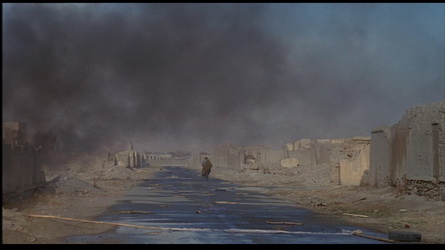 |
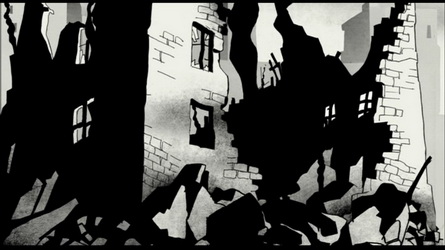 |
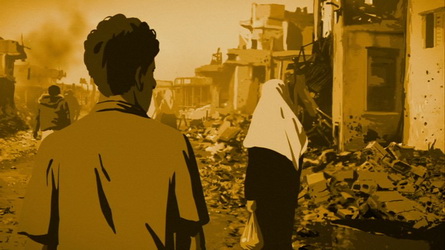 |
||
Miles Gertler Siddiq Barmaq’s Osama, Marjane Satrapi’s Persepolis, and Ari Folman’s Waltz with Bashir all rely on distinct representational styles to convey a sense of anxiety that resonates with their dark content. The wars that generate much of the narrative momentum in each film destroy much of the urban environments in which the action is depicted. To varying degrees of success among the three films, the destruction heightens the aura of anxiety perceived by the viewer.
|
|||||
| x | 4. | 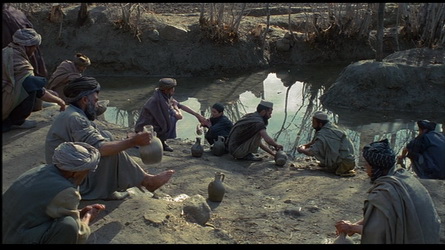 |
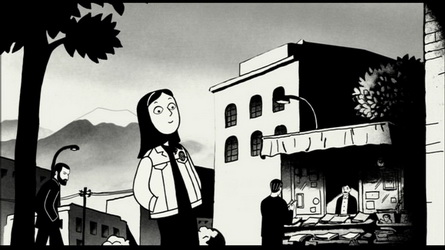 |
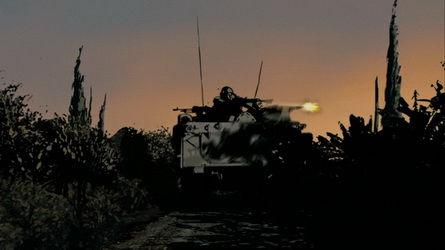 |
x |
Suzan Ibrahim In Osama, landscapes and materials were always elements close to the atmosphere of the movie. It is the main context in which much is grounded. Bloody scenes became real and uncomfortable, and sad scenes because of loss of hair became very real. Its instant impact becomes the major focus rather than a reading following an event. This is the same impact that the girl experienced in her day to day life where most of her everyday life was lived more as an instant instinct rather than strategies over time. Within Persepolis, the animation is the predominant effect. This cartoonish effect draws the focus primarily on the storyline within the movie and the reality becomes a lot more distant. This is not necessarily an effective technique, but might have been necessary to keep an anonymity to the events because of its highly political and social engagement of the subject. Similarly to Persepolis, Waltz with the Bashir has eliminated many details in order to focus more on the actual storyline and leave most of its reading and relation to the actual viewer. However, it contains a lot more context through its warm tonality which makes it somewhat more successful than the simplified animation of Persepolis. Throughout the whole movie, a fictional world is created but it ended accordingly with the actual reality, bringing a strong impact that this "fiction" is in fact a reality by the use of real documented footage of similar events. This becomes a mixture of a "reading" of a movie through its fictional aspects and animation as well as that instant impact by the shock of the real footage in the end.
|
|||||
| 5. | 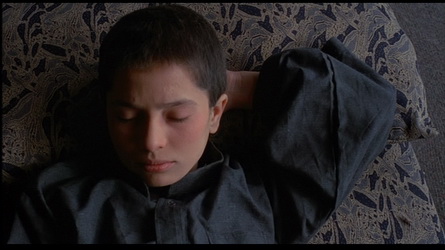 |
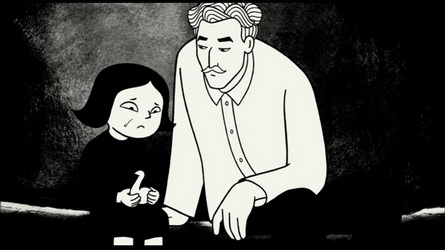 |
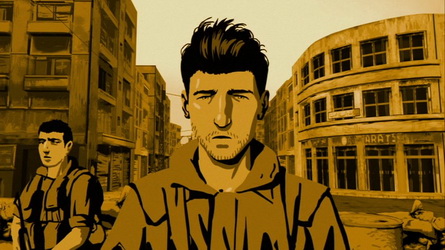 |
||
David McMurchy I found that the different filming/animation methods were effective in different ways in portraying a very difficult subject matter and the character’s experience of war. In the case of Persepolis and Bashir, the movie is animated and narrated. This allows for the distortions of memory from the time elapsed to show through, and emphasize that the movies are not simply a recording of events, but extremely personal recollections of traumatizing experiences. The extremely cartoonish imagery from Persepolis is reminiscent of a childrens’ cartoon, and creates a connection with the character, who’s experiences of war and loss start right from childhood. The simplicity and starkness of colour helps to distill the ideas being presented and turn them into more than just memories of times gone past, but emotions felt by and between characters who are not lost in the background. Bashir, on the other hand, uses a definitely more realistic animation technique in its portrayal of war and the characters’ experiences of it. This method is very effective at immersing the audience into the recollections of war, as animation allows for freedom to recreate events without seeming too contrived. With deliberately realistic animation, the producers don’t need to attempt to film historical pieces and equipment in actual settings, which could come off as fake. The animators can instead focus on visiting the sites and taking what parts of them are crucial to the telling of the memories of them (such as the sunset, or the dust, sounds, etc). Furthermore, by using animations, the producers are able to create very detailed facial closeups in order to capture very potent emotion and transpose them into a recreated, detailed setting, which would be difficult to achieve with live actors. The movie Osama being shot with live action rather than being animated was a good choice, as the events being portrayed are not particularly specific events happening in recollection, but events that are currently happening to to thousands of young women all over Afghanistan. It lends credence to the idea that this film is a documentary of a child’s life and childrens’ lives rather than a single journal entry of memories (regardless of how powerful these are). However good the various methods of filming were in conveying the emotions of the characters for their respective reasons, I found that the most moving films were Persepolis and Bashir, where the events portrayed in the film were distilled to their more basic raw emotions.
|
|||||
| 6. | 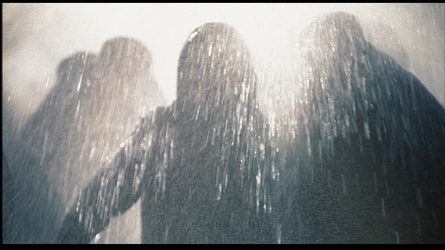 |
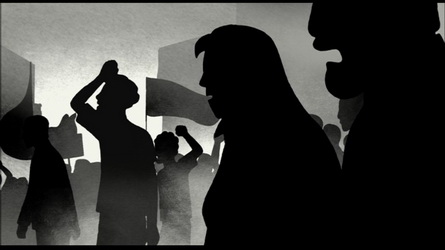 |
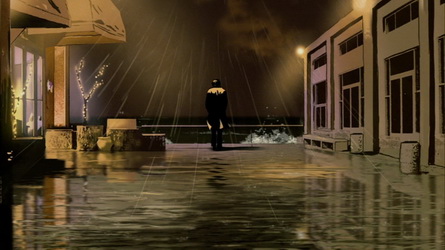 |
||
Benny Or In the film Persepolis, the majority of the film is depicted in black and white animation and therefore the contrasts between the light and darkness was further pronounced. The use of lighting effects is highlighted through the use of still inked drawings as backgrounds to the animated action. I found that the use of this technique created a very strong contrasts between the moving action and backdrop in which it took place. Because of this method of depiction however, I found that it was distracting in sequences that required lighting to express the atmosphere of the scene. Particularly in the scenes of violence where although they were trying depict violence and darkness, I found it almost slightly comical in that it took on a light hearted graphic novel persona. Waltz with Bashir was a middle point between Osama and Persepolis for me. Although the animators are to be congratulated on their artistic abilities to represent the atmospheric qualities of the lighting effects, particularly in the scenes where the water is present and the reflection in the moving waves are rendered beautifully. I found that however it still lacked the fluidity that you find in the way natural light casts on objects in reality. The animators did achieve a heightened sense of atmosphere however through the intense saturation of the colours used. The success of their stylistic choice I think is found in the contrast between their use of colour and lighting that dissociated the animated sequence from being a realistic representation and the final sequence where real footage was shown so that not only was it reality but the atmospheric qualities of the animation remained. Lastly Osama took on a traditional depiction of lighting effects. I personally am more of a fan the realistic rendering of lighting effects because I find that it is the most relatable as we don't normally perceive in animated form. Only real footage is able to capture the fluidity and delicacy of moving light. Both Persopolis and Waltz with Bashir offered the viewers a very different perspective looking at lighting effects but I feel that only through the contrasts between the realistic rendering of light that and it's animated counterpart that allowed the different effects of lighting to be clearly understood.
|
|||||
7. |
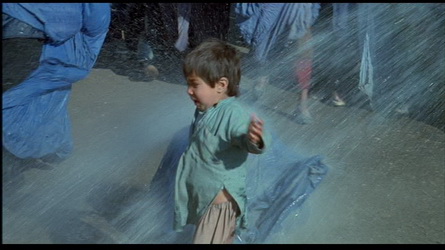 |
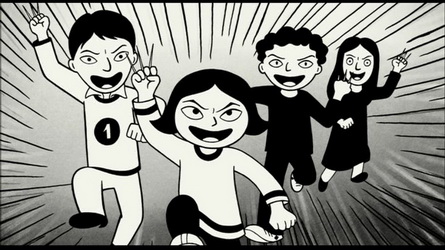 |
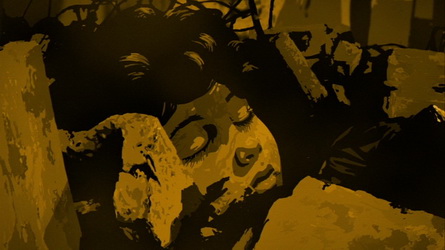 |
||
William Pentesco I believe the filming method of Osama was able to draw out feelings of anger towards abuse of children the most. This is because the cartoonish appeal of the other two films did not embody the same harshness Osama did. The opposite reaction though is that the story behind Osama is completely fabricated (though from true stories) where as the stories in Persepolis and Waltz with Bashir are true.
|
|||||
| 8. | 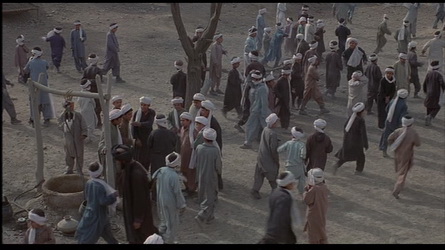 |
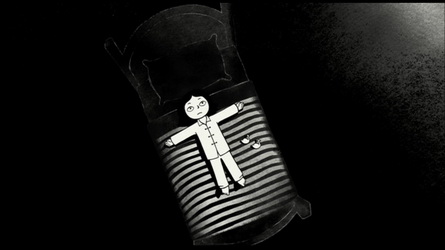 |
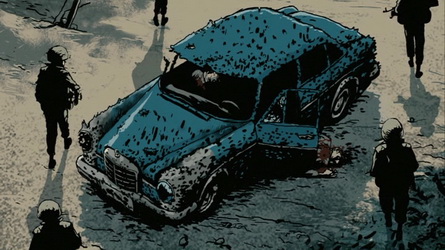 |
||
Emmanuelle Sainte |
|||||
| 9. | 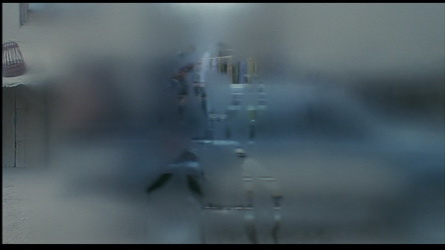 |
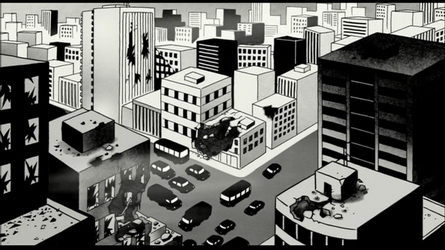 |
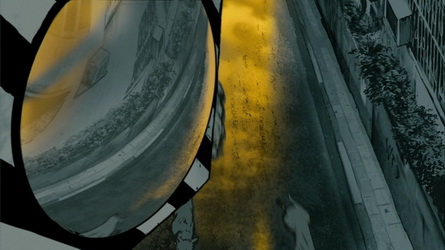 |
||
Tristan Van Leur The materials in the three films are dictated by the desired style of filming set by the director. Each film varied greatly; Osama was a bleak, realistic depiction of the sad and disturbing tale of a young girl’s life in Taliban occupied Afghanistan. Persepolis’ style created a story like nature of an aging activist girl, not willing to be suppressed, and Waltz With Bashir shares the shock and lingering effects of traumatic events suffered by soldiers. Each film chose a unique way to depict each of these things. Waltz With Bashir effectively used a highly stylized animation technique that successfully depicted the disconnect between real life and time served as a soldier. It also successfully portrayed these as memories, and dreams, bringing the viewer into the twisted, not quite accurate world of dreams. Unfortunately, this was not entirely successful. The lack of recognizable texture within the world often the viewer completely disconnected from the emotion of the film. The lack of materiality left too strong of dream like feel, and left the viewer disconnected from the powerful emotion of many of the scenes. In Persepolis, animation is also used. This time it is black and white with extreme high contrast. There is absolutely no materiality in the movie, and it reflects very closely the animation within the graphic novel. The animation of Persepolis although beautiful, detracted from the strength of the narrative; the entire film felt far too light hearted, due to the comic nature of he animation. It made for an enjoyable approachable film, but lacked the severity that a story like that could, and probably should contain. Osama was the most powerful film. It was shot with very little styling and on a tiny budget. The capturing of realistic materiality, unlike the other two, let the audience feel connected and understanding of the country, which in turn made the events happening far more disturbing. The live actors and real sets introduced the audience to the real world, which is far more powerful in an emotional tale that a surreal scene. The lack of materiality in the two other films loses a feeling of reality, and allows the audience to pretend that these atrocities are not actually happening.
|
|||||
| 10. | 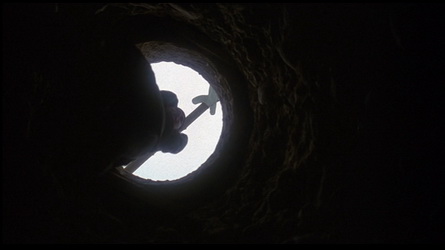 |
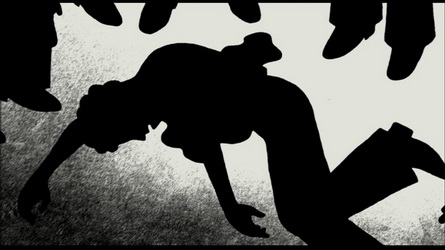 |
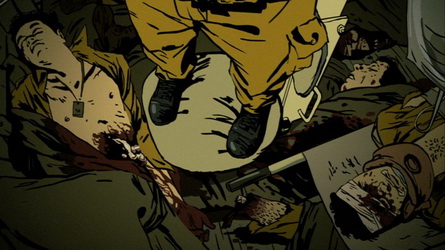 |
||
Benjamin Van Nostrand Animation is an interesting medium for dealing with controversial issues, as it provides the filmmakers with an important opportunity to carefully control how graphic the violence appears. Persepolis chooses to stylize, downplay or abstract many of its acts of violence, either for effect or to reduce the sense of horror associated with graphic violence. Waltz With Bashir almost calls attention to that sense of horror, showing the exposed guts of wounded soldiers lying on the floor of the protagonist's APC. Though this question is largely a matter of opinion that depends largely on personal taste and even moral view, I would argue that the level of violence portrayed in these films is not only appropriate but even necessary. In this case, when all three films can be seen as commentaries about the state of things in what can all loosely be referred to as the Middle East, a certain level of honesty is needed, however brutal it may be. Frank depiction of violence is quite appropriate, indeed even necessary, in order to have the discussion brought up by these three films. As long as the violence is depicted in a relatively realistic way, (and most importantly not dramatized or glamorized) it becomes an invaluable tool in evaluating the situation and developing an understanding of it. Granted, much of this content is shocking, but the state of affairs in real life is more shocking, and if the shock of some animated violence might be enough to catalyze some sort of change then it is entirely acceptable. On a less controversial level, depictions of infringements on human rights, oppression and inequality are all necessary to convey the commentary, why not also be able to freely portray violence? The intent in Osama, Waltz with Bashir, and Persepolis is definitely not to entertain as mindlessly as was the case in Sin City or 300, or to provoke an emotional response to build a bond with the protagonist as might be the case in The Wall. Osama illustrates the plight of women under a fundamentalist government, Waltz with Bashir slowly unfolds the trauma of a man facing the horrors of war, and Persepolis recounts the decline in human rights and the identity crisis faced by the arguably regressing Iranian state. All of these narratives share a foundation based in reality of societies which we in the West see as inherently wrong. The depictions of violence are not invented to put people in theatres, they are relatively accurate examples of things that actually happen. As such, I do not believe that the presence of violence in these films is in any way excessive. If anything, the violence in Persepolis feels somewhat restrained. Though necessary in order to keep the visual style consistent, its depictions of violence almost seem whitewashed. In criticizing or opening to discussion contentious or controversial issues, one needs brutal honesty rather than visual euphemisms.
|
|||||
| 11. | 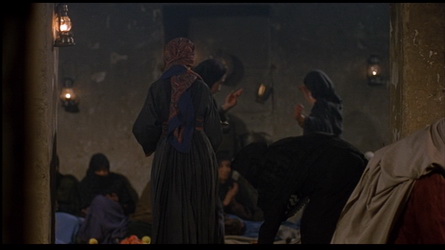 |
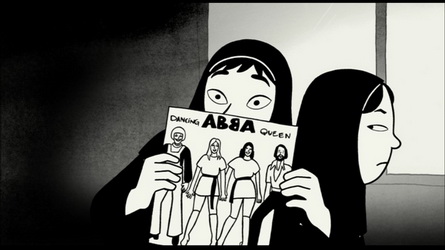 |
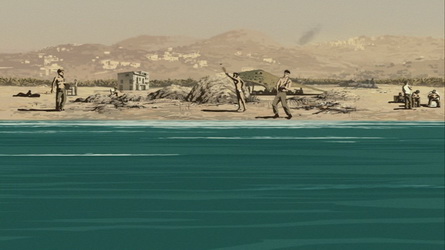 |
||
Shane Neill The effectiveness of the soundtracks is hard to compare among these three films because of the stark differences among them. While all three deal with a protagonist’s life in the midst of contemporary urban warfare, each is filmed within a different genre. Each soundtrack effectively acts within the genre and adds significantly to the overall success of the film. In Osama there is little interruption in the soundtrack’s fidelity to the actions that are happening on camera that evokes the genre of cinéma vérité. The rawness of the sound, the distortion due to wind, and ambient noise contribute the tone of the film and its representation of reality. The first time the soundtrack is deliberately manipulated to heighten the perception of the situation is when the Taliban attack the protesting women with high-pressure water hoses. The sound of the water is amplified over the screams of the running women, and as the little girl is about to reach shelter, the screams are filtered and distorted to a low growl. The next and most powerful use of the soundtrack is when music is introduced to the scene where Osama plants his|her pony tail and then walks out into the city for the first time as a boy. In the composition by Mohammad Reza Darvishi, a woman sings what can be perceived as a heart-wrenching Afghan lamentation. The piece is composed in a vernacular idiom and as such remains within the scope, tone, and mode of the visual documentation. The last time the soundtrack is evoked is when Osama is in prison awaiting trail. The sounds of the scene are suspended and Osama fantasizes about jumping rope. The sound of this sustains then slowly fades out over the camera’s return to the situation at hand. Persepolis’ soundtrack also works well within the chosen genre of the film. It is an animated adaptation of a graphic novel that is meant to appeal to a broad demographic. The author remarked that the central message of the movie was that war and sex-based repression can happen anywhere. Therefore the characters were represented in a generic manner—without explicit ethnicity. The soundtrack reflects this representation. The voices are all dubbed in perfect French, and ambient or city noises are generalized (e.g. there are no establishing shots of minarets are used for scenes in Iran, nor are shots of gothic castles used to establish scene in Austria). Furthermore, the soundtrack embraces many traditional aspects of animated soundtracks. The voices of elders are sing-songy while young children’s voices are cloying. Whimsical cartoonish music is also employed at times. For instance, when the father describes to the young Persepolis how the Shah came to power, the soundtrack fully embraces the cartoon within the cartoon by exaggerating sound effects, comical character accents, and “wha-wha” onomatopoeic musical devices. The musical soundtrack is also rather generalized. There is no use of vernacular composition. Later, when Persepolis comes of age, the sound track features western pop music embraced by teens at that time. Max Richter’s soundtrack for Waltz with Bashir expertly recreates the sounds, music, and atmosphere of the 1980’s Israeli Campaign in Lebanon as the title character tries to reconstruct his lost memories of his role in the Sabra and Shatila massacre. Richter recreates the sounds of the time through the collage of adopted pop idioms, synthesized instruments, and featured rock music contemporary with that era. The opening scenes demonstrate Richter’s techniques for creating sonic nuance throughout the film. The opening credits are scored with bowed vibraphone or its synthesized equivalent that creates a slightly disorienting ambiance. A nightmare scene abruptly interjects. Dogs run through the city scored with synthesized rhythm/bass track and electronic drum that is reminiscent of 80’s suspense or horror films. This sounds so true to the 80’s that one is able to aurally recognize the sequence as a flashback. Also note worthy is the fidelity of the sound effect dubbing. The growling and slobbering of the rabid dogs as they clang into objects in the wet streets achieves a great verisimilitude through expert sound level balance and fluidity of execution. Sounds do not pop out of the texture. The ambient vibraphone score brings the scene back to the present where Bashir describes his disorientation and frequent nightmare. So acutely executed is the soundtrack that the movie could be listened to without any need of images to tell the story. In this manner the reality of the sound lends a sense of documentary reality or believability to the highly stylized images. The remainder of the movie continues this collage of aural fidelity, disorienting ambiance, and reminiscences of songs and sounds of the era. Comparing such different films is helpful in understanding how a soundtrack successfully operates within the scope and purpose of a film. The soundtrack's purposeful adherence or contrast to the use of images can enhance or significantly alter the translation of the image to the audience.
|
|||||
| 12. | 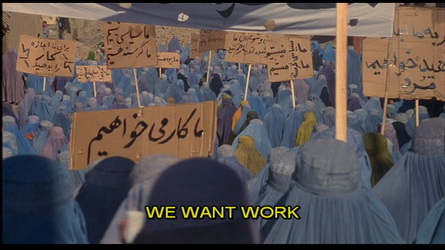 |
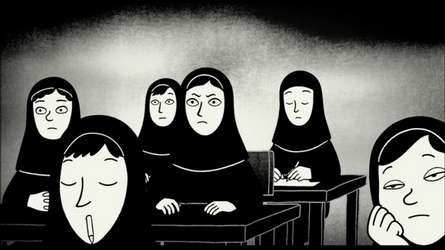 |
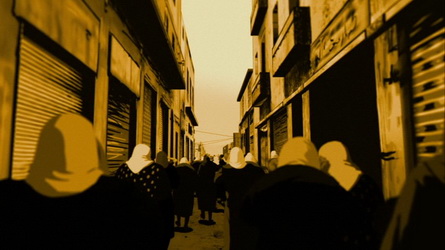 |
||
Michelle Greyling The narrative of the film "Osama", depict the level of injustice toward woman in Afghanistan in an intense and vivid manner. The theme of the film deal with real issues and actual examples and events of persons having lived in Afghanistan during a time of immense oppression. In the film "Osama", the theme of survival lead the narrative and the film depict the extent of which a young girl had been forced to change her identity to survive in a country where females faced extensive levels of injustice. The theme of the film present a young girl that is forced to change her physical appearance to that of a boy to enable her to work, walk in the streets without a male companion and go to school.
|
|||||
| 13. | 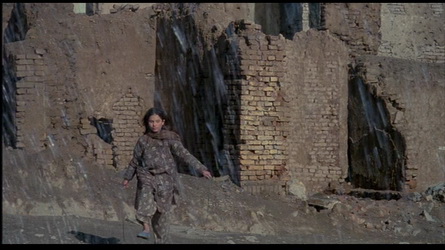 |
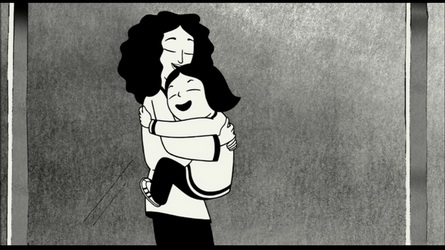 |
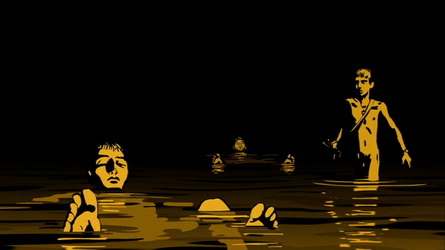 |
||
Richard D'Allessandro In comparing the films, Osama, Persepolis, and Waltz with Bashir, I believe that Osama makes use of the most resonant and impactful flashbacks or dream sequences out of the three. The director uses these narrative devices to successfully drive a heartfelt telling of the story, but also describes the quality of genuine human memory and dreams with eerie accuracy, to the point of adding exceptional validation to the heavy horrors portrayed in the film.
|
|||||
| 14. | 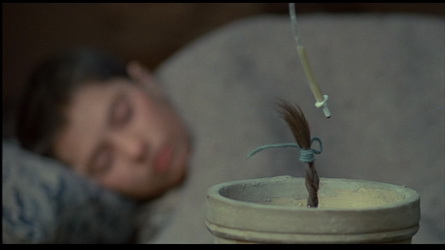 |
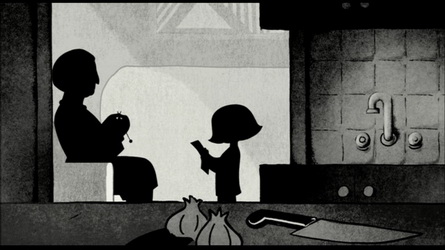 |
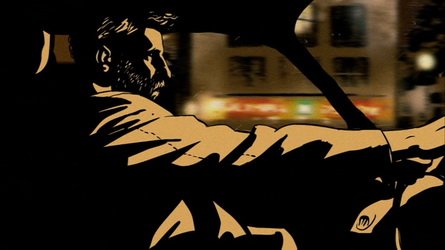 |
||
Talayeh Hamidya
|
|||||
| 15. | 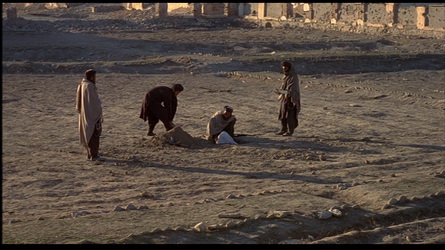 |
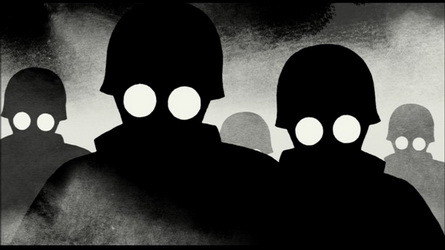 |
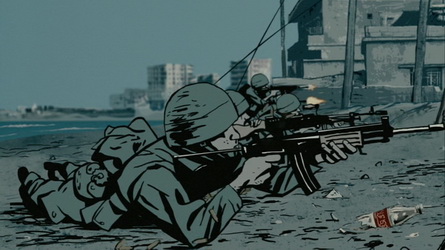 |
||
Maryam Abedini Rad Although these three films are different in their language of telling their stories, but it seems that all of them has their own ways of conveying the points and telling the truth. These languages can be a simple and humor way of telling the truth or a language of reality like a documentary film or even a surreal animated documentary-style. All these kind of movies can be successful and impressive, depends on the power and the way of delivering the truth. I personally, found the Persepolis not more successful but more impressive. It has a very simple way of telling a story to reflex a history of a nation in the form of a biographical narrative. Osama: Waltz with Bashir: In conclusion, if I want to explain whether the methods of making the film assist or detract from their relative success, I can say that definitely it helps, but the nature of narrative is playing the main role and also the language of telling the truth. The genre of the film is also important and can attract its own viewers. In general, it is good to say these awards cannot bring them success but can be helpful in extending the success of these kinds of unique films. Maybe it is worth to say that these festivals are like platforms for these kind of films to be introduced to western world in terms of their culture, customs and history. http://www.timeout.com/film/reviews/84217/persepolis.html http://www.blu-ray.com/movies/Waltz-with-Bashir-Blu-ray/4642/
|
|||||
| 16. | 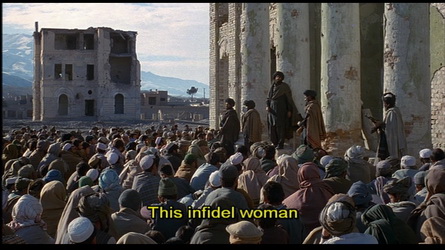 |
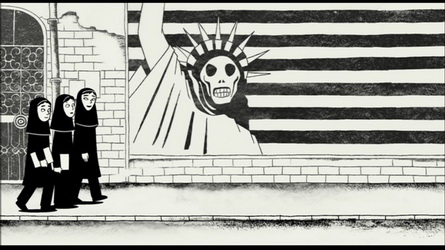 |
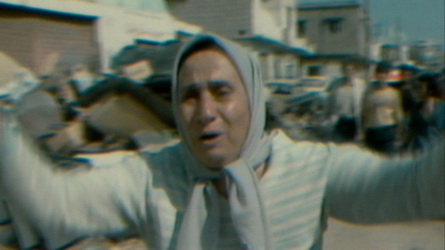 |
||
Jamie Usas Osama, Persepolis and Waltz with Bashir share a common thread of illumination; each weaving it’s own unique path through the often misunderstood cultural history of the Middle East. Stylistically at polar extremes, Osama (live-action) and Persepolis (animation) treat a common theme of political oppression with remarkably uncommon sensibilities, while Waltz with Bashir (live-action/animation) rests somewhere in-between, both in style and sensibility, suppressing the literal expression of genocide through a dream-like collective memory of wavering accountability. Osama’s in-your-face, cinema verite style succeeds in bringing the viewer into a very modest expression of a Taliban occupied Afghanistan. Persepolis, alternately, uses animation to distance the viewer from the details of reality. The story spans Tehran, Vienna and Paris; however, each city is rendered in the same monochromatic black & white style. This treatment, by directors Vincent Paronnaud and Marjane Satrapi, seems to generate a mental continuity across the geography film, suggesting that the oppressive and tyrannical events of one time and place, can in fact easily occur in any other, implying that no border or geographical distance is a safeguard from tyranny. Unlike Osama, Persepolis vanquishes all texture from each setting. The stylistic separations are instead allocated to the divisions of present day (multi-toned color render), past (monochromatic black & white) and memory (black & white). The choice in style suggests that what is of most significance is not the “literal” history interpreted by the film. Rather, the film focuses on the shifting headspace of the female protagonist, Marji, and how she perceives that changing world around her. Waltz with Bashir uses a stylized, rotoscopic-like animation to convey the perspective of the unreliable narrator and his fragmented memoires. The film follows a middle-aged, Israeli veteran of the Lebanon war, as he struggles to recover memories so traumatic that they have been repressed from his conscious mind. A surrealist quality pervades each scene of the film, urging the viewer to constantly question the truth of scene, or even to question if truth actually exists beyond the memory of the perceiver. What Bashir excludes in textural detail is replaced with poetic affect generated from the film’s surreal memory sequences. The filmmaker employs highly stylized and emotionally driven scenes to bring the viewer deeper and deeper into the mind of Ari. As each memory is revealed, the viewer is confronted with the shifting rational and irrational perspectives of young soldiers forced into a war that they can hardly understand and struggle to relate to. The film climaxes with a juxtaposition of two sequences focusing on the aftermath of genocide and it’s discovery by Lebanese women and children. First rendered in the surrealist animated memory of Ari and followed by an actual video clip of the same genocidal event, marking both the end of Ari’s amnesia, and the beginning of global news coverage of Lebanon’s genocide. The affect of this juxtaposition is sobering. The film jumps from a surreal, languidly drifting, stabilized frame of dream-like memory to the jittery handheld anxious frame of real events captured in real-time. The transition between animation and live-action acts like a veil that lifts all the surrealist distance established in the preceding scenes. The shifted perspective removes the viewer’s relation to Ari and his experiences as a soldier and positions the viewer in the reality of found-footage and the unbearable reality of human beings discovering the genocide of loved ones.
|
|||||
updated 28-Dec-2011 2:35 PM